In ZEAH systems, the predominant species is the biomass of algae and bacteria used to cycle nutrients

Most environmental concerns about current aquaculture practices can be addressed effectively by zero exchange, aerobic, heterotrophic (“ZEAH”) culture systems (Boyd and Tucker 1998). Although these systems are already in limited use, their number is growing rapidly because they represent a sound way of responsibly addressing water use and effluent discharge in profitable aquaculture operations.
However, these systems require significantly higher construction and operating costs, and to offset these, zero exchange systems typically operate at significantly increased stocking densities and production. At Meridian we have found four main factors that contribute significantly to the successful utilization of ZEAH systems: proper species selection, provision of appropriate structure in the culture tanks or ponds, control of flow velocities, and proper nutritional input for ZEAH systems.
Shrimp farming and zero-exchange systems
Average production from shrimp farms in the Western Hemisphere is only 931 kilograms per hectare (Rosenberry 1988). In 1998 there were only 30 intensive farms, producing an average yield in excess of 3,000 kilograms per hectare. While the average stocking density reported for Central American “intensive” shrimp farms averages only 40 PL per cubic meter, most zero exchange systems today utilize stocking densities in excess of 60 PL per cubic meter, with some working at densities as high as 500 PL per cubic meter. Intensive shrimp culture is defined here as producing yields of 0.5 to 1.0 kg per cubic meter (5 to 10 tons per hectare), super-intensive as 1 to 5 kilograms per cubic meter (10 to 50 tons per hectare), and hyper-intensive as producing over 5 kilograms per cubic meter.
Conducted properly, zero-exchange aquaculture can produce 10 to 50 times the average production in a given area and, at the same time, totally disassociate the site from the coastal management zone. As an example of this, Meridian Aquatic Technology, LLC, has grown Pacific white shrimp (Litopenaeus vannamei) at stocking densities of 500 PL per cubic meter, achieving yields of 8.1 kilograms per cubic meter (71,250 pounds per acre) in Montana (USA), a thousand miles from the nearest ocean. Zero exchange offers the potential to totally decentralize aquaculture in the very near future.
Proper species selection
To really benefit from the aerobic digestion system, the species cultured should efficiently use the detrital floc (aggregates of single cell protein, SCP) as a feed source. This results in nutrients being more completely utilized in the system, and nitrogen incorporation into the tissues of the cultured species is higher. Detrital feeder species include penaeid shrimp (L. vannamei, L. stylirostris and P. esculentus), tilapia (Oreochromis sp.), carps (Cyprinidae), and mullets (Mugil sp.). Genetic selection processes have identified varieties among these species that are better suited to high-density culture than others. Also, not all shrimp are appropriate for heterotrophic culture techniques. Species like P. monodon or P. japonicus make little use of the SCP generated in ZEAH systems, and their feed conversion ratios (FCR) and inorganic nutrient recovery are not as efficient.
In ZEAH systems, the predominant species is not the harvested species (e.g., shrimp), but the biomass of algae and bacteria used to cycle nutrients in the system. In a typical commercial system, such as Belize Aquaculture (featured in detail in previous issues of he Advocate), the total bacteria biomass in the system exceeds the harvested shrimp biomass by two to five-fold. Hence, the management practices necessary for ZEAH systems are those necessary for the optimization of microbial culture, not for the shrimp, which benefit at a secondary trophic level.
Provision of engineered surface area
For benthic detrital feeders like shrimp, a key problem is increasing the surface area in a pond to provide more grazing space and reduce cannibalism. In their natural environment, estuaries, sea grasses and mangrove roots provide the structure necessary for these benefits. In zero-exchange systems, the provision of structure such as the commercially available AquaMats® can bring significant improvements in survival and nitrogen recovery from detritus. The use of the third dimension in the water column – water depth – allows a significant reduction in shrimp population density per unit volume.
With the benefit of work from artificial reef research (Seaman and Sprague 1991; Jensen and Lockwood 2000), we have proven the importance of vertical dispersal to survival, and have developed highly engineered surfaces to provide habitat for ZEAH systems, as well as conventional culture systems to increase the survival and health of culture species, particularly shrimp species. Early in the early development of AquaMats®, we identified the basic benefits as follows:
- A continuously available natural feed supply through the generation of periphyton;
- Engineered structure to disperse the animals in the water column and reduce cannibalism; and,
- In-situ biofiltration, as a result of the metabolism of the periphyton cultured on AquaMats® surfaces.
The Belize aquaculture experience
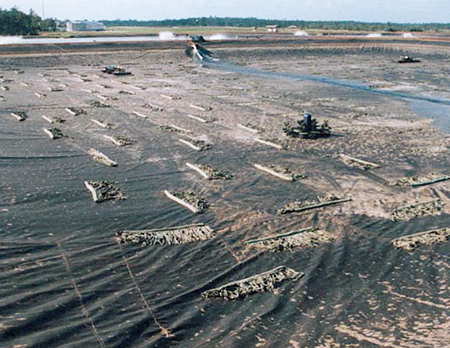
Belize Aquaculture, Ltd. provides a good example of what can be achieved by the deployment of AquaMats® in a well-managed ZEAH system. Last fall, Belize Aquaculture performed a direct comparison between ZEAH practices with and without AquaMats®. AquaMats® were deployed at 1,100 square meters per hectare, and stocking densities of 73 PL per cubic meter were utilized in a 139-day growing season. Ponds with AquaMats® produced 24,951 kilograms per hectare, while control ponds produced 19,395 kilograms per hectare.
The AquaMats® ponds experienced a 29 percent increase in biomass yield, along with a 14 percent decrease in FCR. The nitrogen assimilation efficiency (NAE) in the AquaMats® ponds increased from 38 percent to 49 percent. The latter is particularly important in that the 26 percent increase in nitrogen assimilation represents 150 kilos of nitrogen that did not end up being discharged to the settlement basin. Since nitrogen content (as protein) is the most expensive component of feed on a bulk basis, any improvements in nitrogen assimilation decrease feed costs and FCR. Also, while some of the biomass yield differential is attributable to increased size (AquaMat® pond shrimp were 11 percent larger), the majority of biomass recovery is attributable to improved survival, which increased 32 percent in the AquaMats® ponds. Thus, 75 percent of the total biomass recovery improvement is attributable to improved survival.
The industrias pecis experience
An example of improved productivity based on techniques closer to conventional practices is afforded by Industrias Pecis (Merida, Mexico). In their winter cycles this year, they successfully maintained their system as zero exchange in unlined, 1.5-ha ponds for 95 percent of the growth cycle, using AquaMats® at 733 square meters per hectare. Stocking density was 110 PL per cubic meter in a 108-day growth cycle. Their control ponds produced 6,156 kilograms per hectare with 74 percent survival, while AquaMats® ponds achieved 7,608 kilograms per hectare with 86 percent survival. Although the shrimp were 6 percent larger on AquaMats®, the principal contribution to biomass yield improvement was attributable to a survival improvement of 17 percent.
Relationship between available structure and stocking density
Extensive field work by Meridian Aquatic Technologies, LLC and its client base has shown a linear correlation between available structure and stocking density support. Over the past three years, the accumulated database with our clients has shown an average survival increase of 14.2 percent, in pond studies where AquaMat® ponds and controls were stocked at the same density. The average survival actually increases with stocking density. The data in the accompanying graph reflects the average survival improvement based on the harvested biomass in the system.
Control of flow velocity
A parameter key to maximize recycling organic utilization within the system is the provision of adequate flow velocity throughout the pond, to maintain organic particulates (flocs) in suspension without re-suspending inorganic clays or other fine sediments. The vast majority of super-intensive, zero exchange shrimp systems currently utilizes liners to eliminate this problem of sediment suspension and erosion.
In Australia, Peterson (2000) has recently modeled for the first time the flow in a pond, and demonstrated that in much of the pond, flow is typically excessive to the needs for maintaining the organic matter in suspension. Behavioral studies by the author have shown that detrital feeders prefer a calm benthic environment, with lower flow velocity than is characteristic of typical paddlewheel aeration systems. Pond culture, conducted with paddlewheels for aeration, typically loose 15 to 40 percent of the pond bottom to flow velocities that are excessive for optimum feeding behavior. The loss of pond bottom area causes further relative crowding and increased animal stress. Our work with AquaMats® products has also shown they can be effectively used as flow baffles or diverters to improve average pond flow characteristics and maximize the available bottom feeding area.
Proper nutritional input
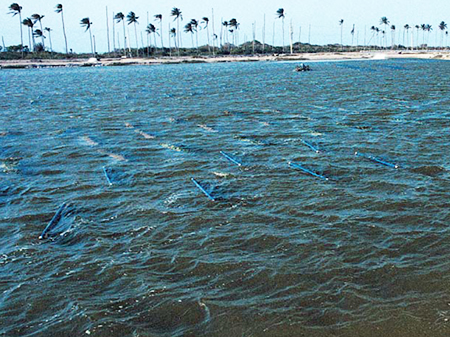
There are unique opportunities and problems associated with nutrition and feeding in ZEAH systems. With the increased stocking densities utilized in zero exchange (500 PLs per cubic meter vs. 15 to 20 PLs per cubic meter), feed quality and nitrogen content become key issues. While traditional shrimp culture systems in the Western Hemisphere utilize feeds with 25 to 35 percent protein content, effective levels in ZEAH shrimp culture are in the range of 18 to 24 percent protein content. It must be remembered that most of the nutrients (feeds and fertilizers) added to the system are still there at the end of the cycle.
As an example of the problems that can arise, we noted a continual rise in copper levels in ZEAH culture systems at Meridian’s facilities in Montana. A detailed ICP analysis of the feed in which the micro mineral mix had been omitted showed the presence of 1 to 4 ppb copper. In discussions with Dr. Albert Tacon (Oceanic Institute, Hawaii), we learned that some feed manufacturers use copper as a catalyst in urea/formaldehyde binder formulations. While perfectly acceptable with almost any level of water exchange, this practice resulted in copper reaching lethal levels (5 to 7 ppm) at the end of the growth cycle in our system. To date, we have identified seven metals that accumulate in ZEAH systems, resulting from aquafeed addition. Accumulation of metals with known toxicological effects (such as copper and aluminum) is an aspect of feed formulation that has received little or no attention to date. This indicates that feeds used in true zero exchange systems must be specifically formulated for that purpose. These formulations may be more expensive from an analysis/content or binder technology standpoint, but these costs are more than offset by the reduction of protein required in the diet.
It should also be pointed out that these diets significantly reduce the amount of fishmeal (as a protein resource) used in feed manufacturing. In fact, if the protein being provided in the diet is principally targeted at the microbial population, fishmeal can be largely eliminated in detrital feed systems, and plant proteins substituted in the feed formulations.
Conclusion
As the industry increases its attention and focus on zero exchange and reduced environmental impact, we must reduce stress on the reared species. Studying animal behavior in the wild can provide many clues as to methods for reducing stress that the animal experiences in aquaculture. Implementing proper species selection, provision of suitably engineered structure, an improved flow environment, and increased attention to nutritional inputs will allow the industry to consistently achieve the greater production capacity that is necessary to justify the higher capital and operational costs of recirculation systems. At the same time, ZEAH and its system variants can significantly reduce any environmental impact of these operations.
Acknowledgments
The author wishes to express his sincere gratitude to those commercial growers and researchers who have invested so much of their time and effort in the use of AquaMats®. In particular, the author would like to thank Drs. Steve Hopkins, Tzachi Samocha, Yoram Avnimelech, Craig Browdy, Delma Bratvold and Shawn Moss, as well as Messrs. Robins Macintosh, John Ogle and Wynn Pettibone. Thank you for your splendid efforts.
Note: Cited references upon request to the author.
(Editor’s Note: This article was originally published in the June 2000 print edition of the Global Aquaculture Advocate.)
Now that you've reached the end of the article ...
… please consider supporting GSA’s mission to advance responsible seafood practices through education, advocacy and third-party assurances. The Advocate aims to document the evolution of responsible seafood practices and share the expansive knowledge of our vast network of contributors.
By becoming a Global Seafood Alliance member, you’re ensuring that all of the pre-competitive work we do through member benefits, resources and events can continue. Individual membership costs just $50 a year.
Not a GSA member? Join us.
Author
-
Roderick McNeil, Ph.D.
Meridian Aquatic Technology, LLC (Montana Office)
303 Kerr Dam Road
Polson, Montana 59860 USA
www.aquamats.com
Tagged With
Related Posts

Health & Welfare
Development, implementation of shrimp health programs require integrated effort
Shrimp health management focuses on disease prevention through good nutrition, sound pond management, and stress reduction rather than disease treatment.
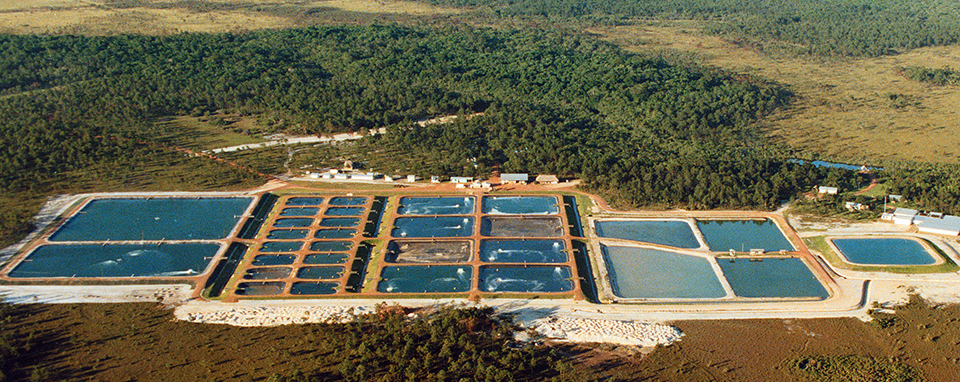
Intelligence
Microbial communities affect water quality, shrimp performance in Belize
Belize Aquaculture’s approach to shrimp farming uses selectively bred stocks, feed input with less than 20 percent protein and water recirculation at harvest.
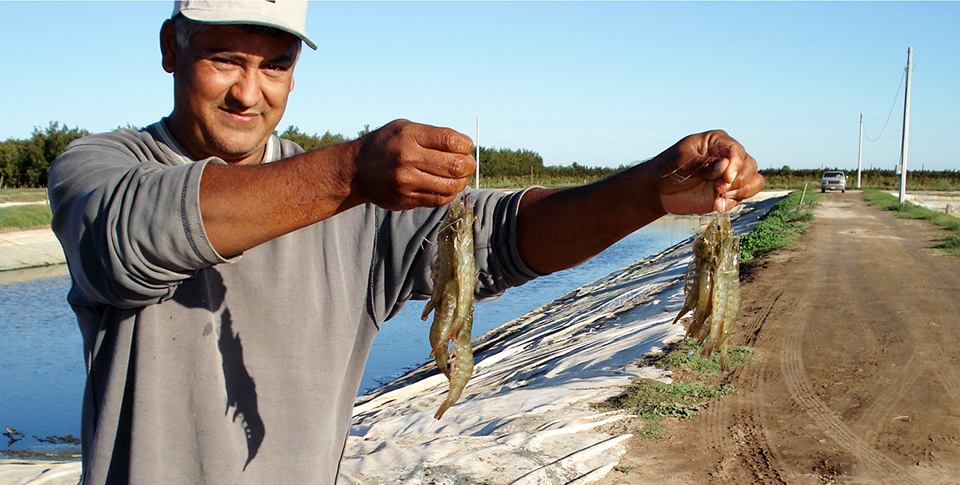
Health & Welfare
Shrimp study uses low-salinity groundwater in Sonora, Mexico
Trial demonstrated that inland shrimp farming with Pacific white shrimp in Sonora, Mexico, is a viable alternative for the use of groundwater where agriculture has been eliminated by the salinity in the aquifers.
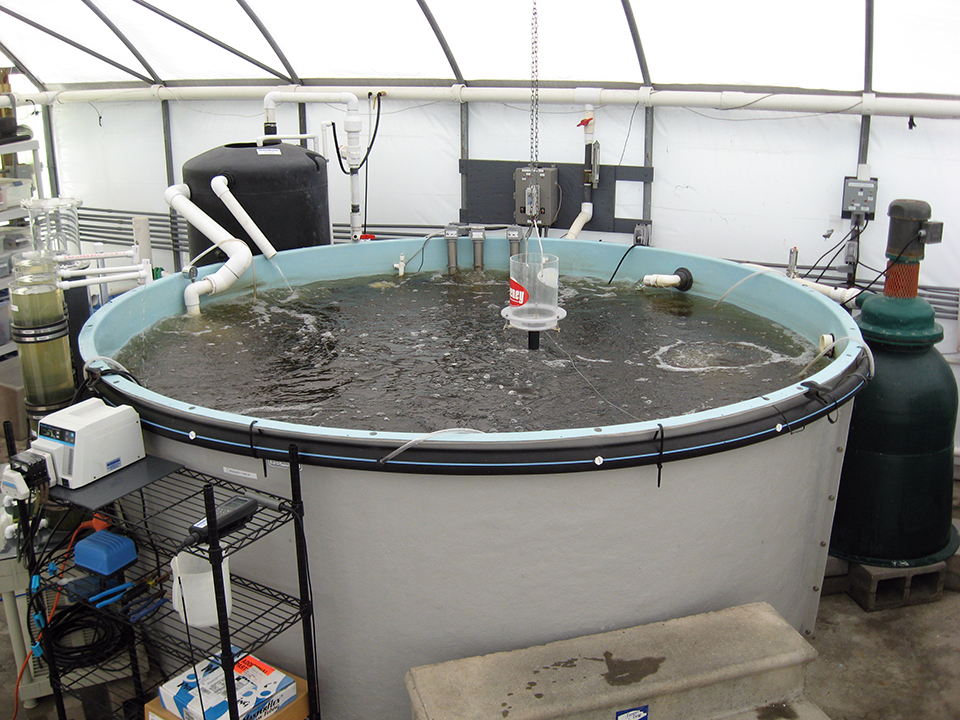
Responsibility
Biofilter start-up problems? Just add sugar!
One way to jump start biofilter operation is by adding sugar, which can provide sufficient organic carbon to neutralize the ammonia-nitrogen produced.


